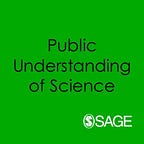Introducing science through images: cases of visual popularization
Review by Mark Erickson
The book’s strength lies in its analysis of photographs that are emerging in environments without strong genre conventions and contexts.
This book addresses an important question: how do images in popular science texts contribute to audiences’ understandings of science? Maria Gigante uses tools and techniques from rhetorical analysis to examine four different deployments of static visual images (‘portal images’) that are combined with texts that promote or popularise science. These are: the frontispieces of science books published in the Classical age (to borrow Michel Foucault’s designation), scientist-at-work portraits from the mid-20th century, popular science magazine cover images from the early 21st century, and contemporary online science-art competition images.
‘Portal images’ lead the viewer to an understanding of the text they precede or accompany and will influence viewers’ perspectives on the text. Throughout, Gigante argues that the portal images presented here serve to mystify science through invoking mythic themes, through invoking the superiority of science, through the use of fantastical themes, and through the celebration of indeterminacy.
Arguing from a Critical Understanding of Science in Public (CUSP) or Critical Science Literacy perspective, Gigante presents a small number of criteria that should be used to ensure that images are not mystifying or empty, but instead explain how science is done, and actually contribute something to revealing what science really is.
The book’s strength lies in its analysis of photographs that are emerging in environments without strong genre conventions and contexts. The analysis presented here of the ‘scientist-at-work’ portrait, a case study of Life magazine features on science, is very useful as Gigante identifies a number of themes in the images — valorization of science, impersonality of science, scientist as creator / destroyer — and concludes that these portraits set up a ‘figurative “access denied” sign in front of the scientific enterprise’ (p49). Similarly, the powerful takedown of science-art competitions, with their emphasis on ‘wow factor’ images and systematic exclusion of appropriate explanatory texts provides a useful critique of an emerging visual form.
The book is less convincing when it considers images that are embedded in other media, particularly when genre and financial contexts are coming to bear. Authors’ intentions may well be of significance in how a frontispiece is drawn, or a cover design chosen, but as we know from history of art and from cultural studies, intentions are deployed in a wider framework of cultural practices and conventions.
The chapter on popular science magazine covers makes some good points, but often proceeds by assertion and downplays the context that surrounds these cover images, namely that of selling science, in favour of ascribing intentionality. Some images may be misleading or overselling, but New Scientist covers as ‘fantastical’ (images of female heads) or Science Illustrated as pandering to readers with ‘science fictional bugs’ (where the image is of an ant)? Popular science is a genre and it has its own genre conventions which magazine covers adhere to; it is also a business and, for example, New Scientist will deliberately put an image of a woman on the cover to boost sales.
The chapter on frontispieces deploys some very interesting examples, but this section feels anachronistic, bringing contemporary analytical contexts to the world of 17th century science, a world where it feels wrong to suggest there even was ‘popular science’. I was not convinced by the claim that frontispieces to 17th-century science texts that used mythological themes were deliberately mythologizing or mystifying science: would we say the same for, say, Hobbes’ frontispiece to Leviathan or, to take an 18th-century example, the frontispiece to The New Science by Vico — a frontispiece that Vico himself devotes the whole of the first chapter of his book to describing and explaining? Frontispieces at this time were de rigueur for books, and also a genre. As an aside, both Vico and Hobbes would likely be startled by Gigante’s claim that ‘[t]he term “science” was not coined until the 1830s’ (p15).
Overall, this is a book that makes some bold claims, some of which it sustains, and draws our attention to aspects of science in society that are often overlooked by STS scholars. Whilst not all of Gigante’s points hit their mark, the book does provide an interesting and clearly argued set of criteria by which we can appraise images accompanying popular science texts.
Mark Erickson is Reader in Sociology and Director of Postgraduate Studies at the University of Brighton in England. He is the author of Science, Culture and Society: Understanding Science in the 21st Century (2nd ed. Polity, 2015).
